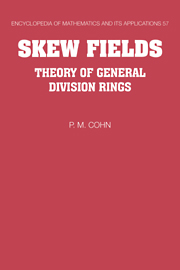Book contents
- Frontmatter
- Contents
- Preface
- Note to the reader
- Prologue
- 1 Rings and their fields of fractions
- 2 Skew polynomial rings and power series rings
- 3 Finite skew field extensions and applications
- 4 Localization
- 5 Coproducts of fields
- 6 General skew fields
- 7 Rational relations and rational identities
- 8 Equations and singularities
- 9 Valuations and orderings on skew fields
- Standard notations
- List of special notations used throughout the text
- Bibliography and author index
- Subject index
3 - Finite skew field extensions and applications
Published online by Cambridge University Press: 05 November 2011
- Frontmatter
- Contents
- Preface
- Note to the reader
- Prologue
- 1 Rings and their fields of fractions
- 2 Skew polynomial rings and power series rings
- 3 Finite skew field extensions and applications
- 4 Localization
- 5 Coproducts of fields
- 6 General skew fields
- 7 Rational relations and rational identities
- 8 Equations and singularities
- 9 Valuations and orderings on skew fields
- Standard notations
- List of special notations used throughout the text
- Bibliography and author index
- Subject index
Summary
The beginnings of commutative field theory are to be found in the theory of equations. The analysis of algebraic equations with the help of groups led to Galois theory, but in a modern treatment Galois theory is developed abstractly and equations enter at a relatively late stage. In the non-commutative case it turns out that a Galois theory can be developed which closely parallels the commutative theory, and this is done in 3.3, using the Jacobson–Bourbaki correspondence (3.2) and some basic facts on dimensions in 3.1. By contrast, equations over skew fields are much harder to handle and what little is known is presented in 3.4. In any case, the appropriate tool to use is a matrix; our knowledge of matrix singularities is even more sparse, and an account will have to wait until Ch.8.
The rest of the chapter deals with various special cases, in which more can be said: quadratic extensions (3.6) and the slightly more general case of extensions generated by a single element with a skew commutation rule, the pseudo-linear extensions (3.5). For outer cyclic Galois extensions 3.7 gives a fairly complete description, due to Amitsur, while the infinite case is briefly dealt with in 3.8.
The last section, 3.9, dealing with the multiplicative structure of fields, forms a separate subject not directly related to the rest. Its location here is determined by the fact that it uses some results from 3.4 but none from later chapters.
- Type
- Chapter
- Information
- Skew FieldsTheory of General Division Rings, pp. 93 - 151Publisher: Cambridge University PressPrint publication year: 1995

